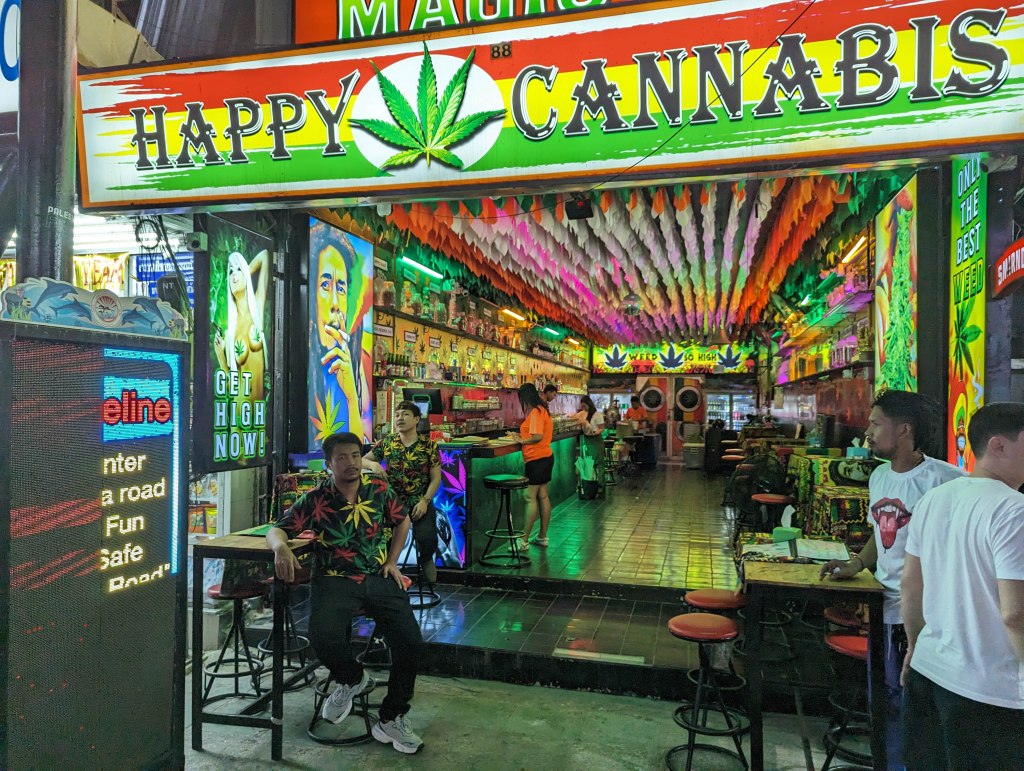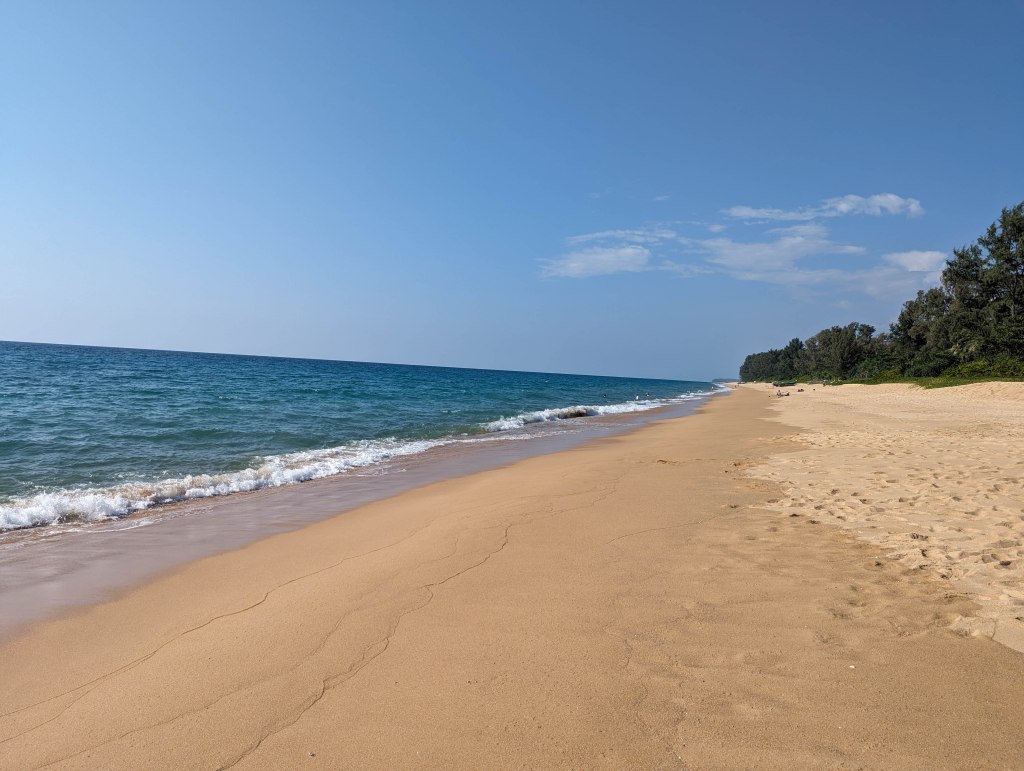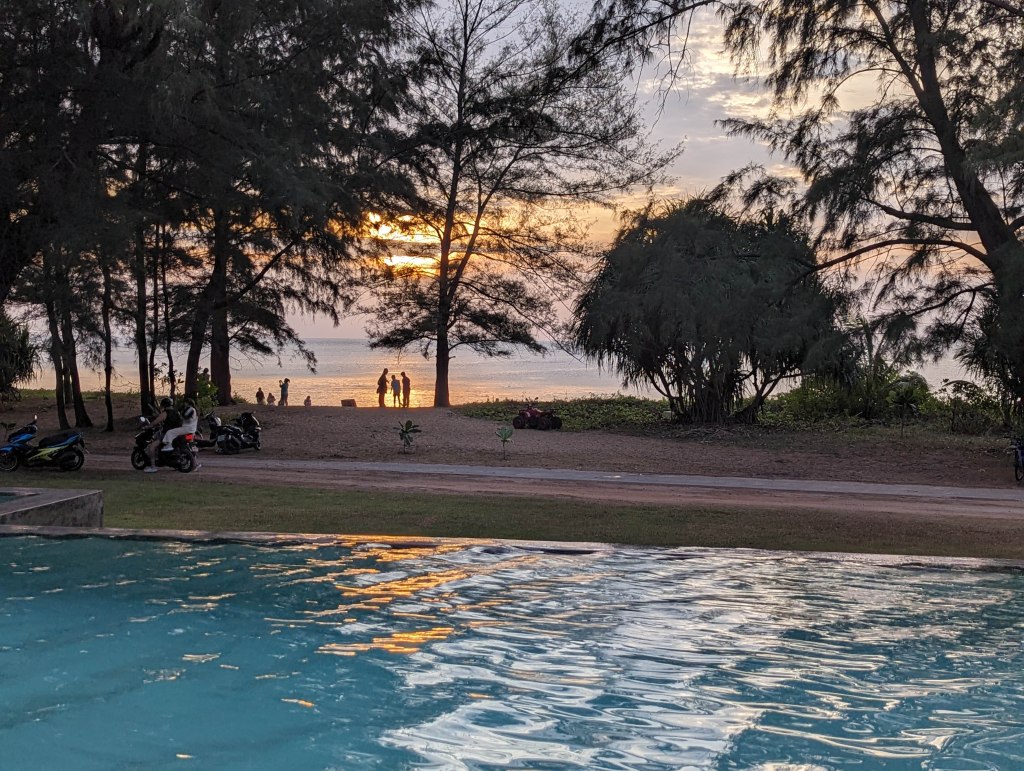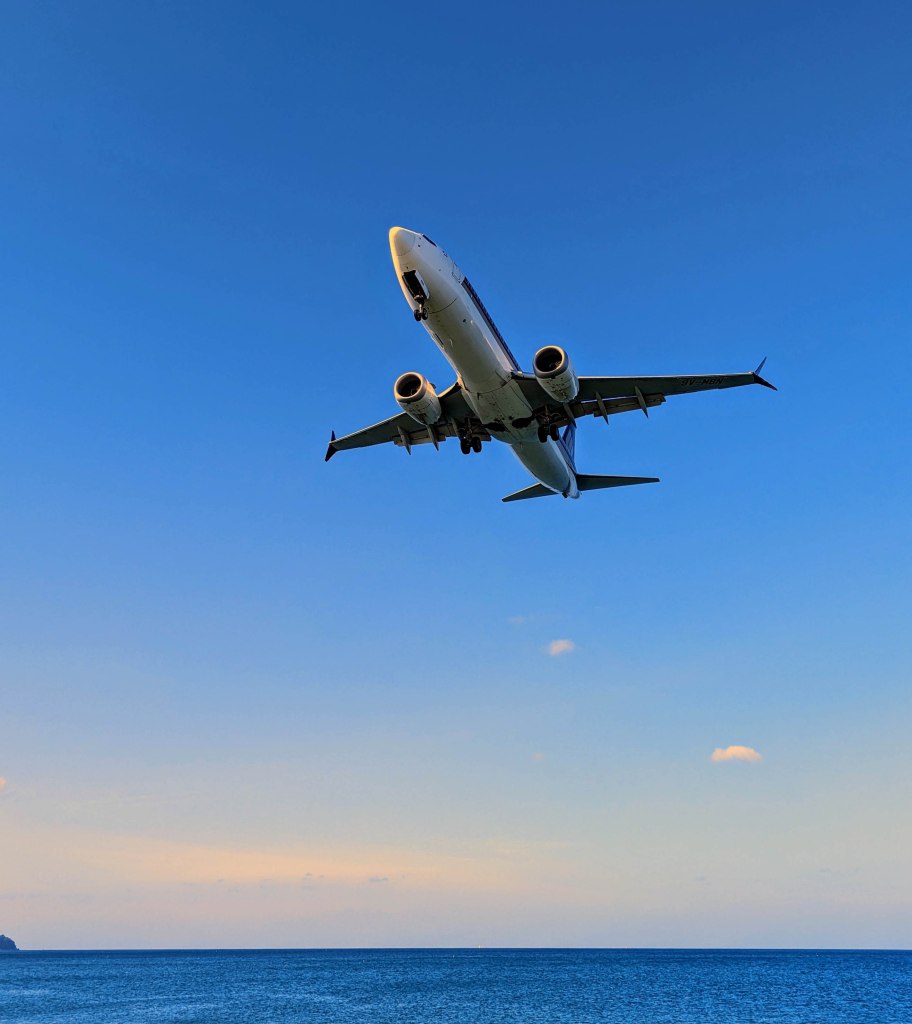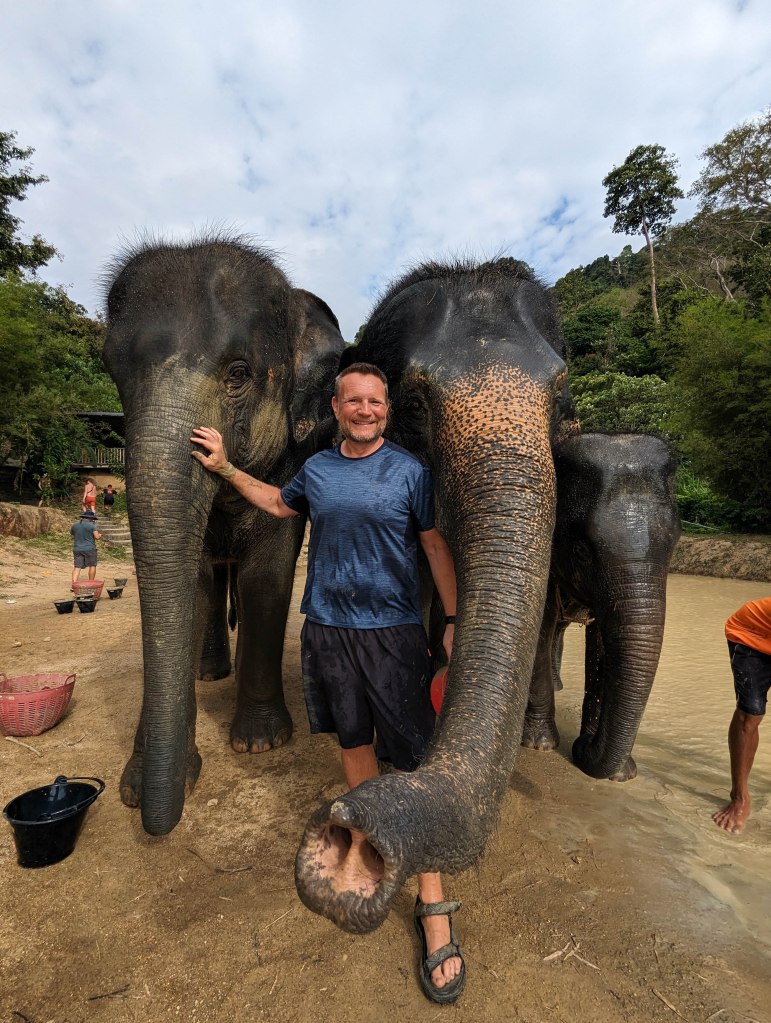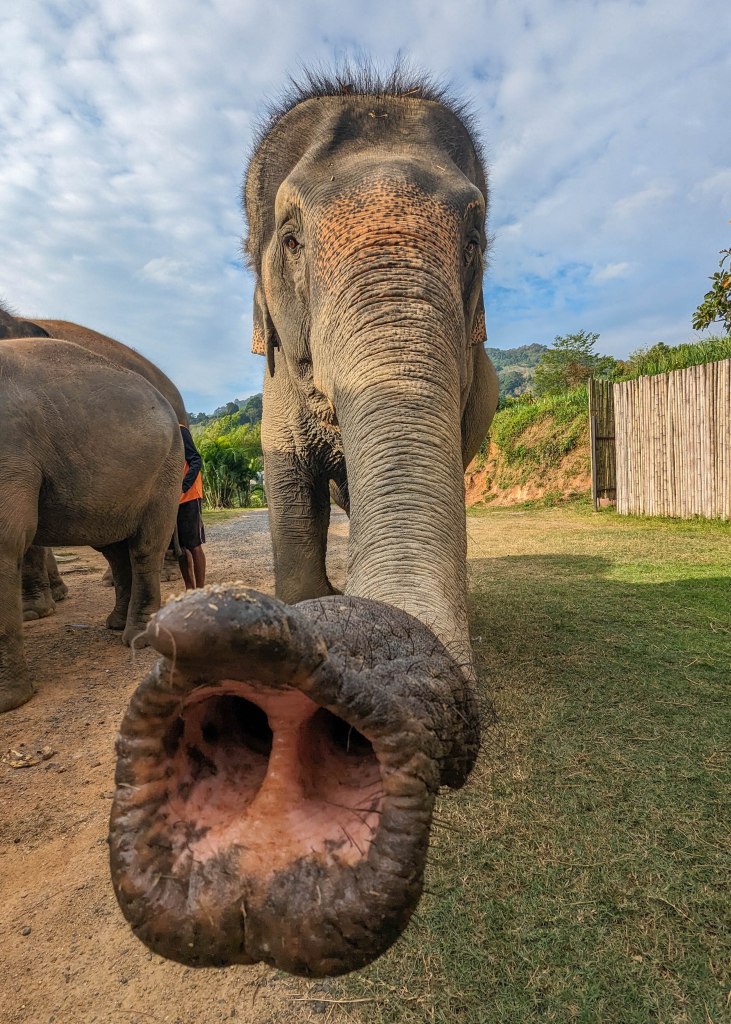Ha Giang
At a street food stall in Da Nang we had met two backpackers who told us they were going to do a motorbike trip in the far North of Vietnam. This was the first we had heard of the Ha Giang Loop.
Some research later, our interest was piqued and we were sold on the idea of this 350 Kilometre loop around the very North of Vietnam, which reaches to within sight of the Chinese border. So once in Hanoi we arranged the trip through our hotel. You can hire motorbikes and do the loop yourself or in a group following a guide but we chose the Easy Rider option, i.e. travelling pillion with our drivers as guides. The roads are rough and can be treacherous in places so it is much safer to be driven (although much less comfortable), with the added bonus of being completely free to enjoy the views.

While we were in the North of Vietnam there was an unseasonal spell of bad weather which brought with it much lower than average temperatures, in single digits. As we had come on the trip with no warm clothing we had little choice other than to buy some warm weather gear for the trip. Fortunately, the old quarter of Hanoi has lots of shops selling knock-off North Face clothing, so for around US$20 each (after some pretty intense haggling) we each came away with a warm down jacket and a waterproof outer jacket of surprisingly good quality, to keep us warm and dry.
The trip started with a 7pm pick up from our Hotel in a little minibus to take us to rendezvous with a sleeper bus for the 6 hour journey to the town of Ha Giang, which is the starting point for the loop.

The sleeper bus was really comfortable with flat beds, curtained-off into private alcoves for each person. The Vietnamese onboard were fitting at least two to each bed but that would have been far too cramped for us. The journey flew by as we sped through the darkness and arrived outside our guesthouse in Ha Giang at 2.00 in the morning.

We were directed upstairs with the other travellers to the sleeping area, which turned out to be a large space (with areas separated by curtains for privacy), filled with very thin and incredibly firm, mattresses on the floor – oh to be back in the comfort of the bus! We were however pretty tired by this time, so we did manage to get some sleep despite being pretty uncomfortable and what seemed like a party going on downstairs.

In the morning, with all our layers on, we came downstairs for breakfast, met our drivers and were kitted out in a helmet and red high-viz vest. Our guide, Windy, introduced himself and explained that we were the only ones that had booked the four-day loop (everyone else on the bus had booked the three-day option – maybe they knew something we didn’t!). On the plus side, this meant that we would be getting a private tour! When we got to the bikes we were a little surprised by their size, having assumed they would be similar to the bikes we rode on the Hue tour in central Vietnam. In fact, once our bags were strapped to the back, there really wasn’t a lot of room for us to sit comfortably. We started to think it might be a very long 4 days!

It didn’t take long for us to leave the town behind and head up into the mountains, surrounded by terraced rice fields. Growing rice up here is much harder than in the South where they are able to harvest four crops a year – only one per year is the norm up here.

Our first major stop was a viewpoint called Heaven’s Gate with a fantastic view over a neighbouring valley… allegedly. Unfortunately, due to the poor weather we would have to use our imaginations, here and at many of the viewpoints along the way. The whole region was socked in with low lying cloud that persisted for the whole trip. This meant that every time we headed up over about 850m we went straight into the cloud layer and there was nothing to be seen.

We started to realise that the bike tours had specific routine stops along the route, many of which were high up at the ‘stunning’ viewpoints. It took a couple of days for our guide to understand that we would prefer to stop below the cloud line so we could enjoy some views, rather than right up in the usual spots where it was a complete whiteout.

After dropping down from the mountain pass we visited a village called Lung Tam and a family that has been making clothes and material the traditional way for 100’s of years. The oldest member of the family was in her 80’s and still working every day. It was a fascinating insight into traditional methods of production.

It was with some relief when we reached our stop for the night, just outside the town of Yen Minh. We were shown to our room, which had missing panes of glass in the window – with the temperature already in single figures by late afternoon and dropping. After a quick discussion we got a new room – still no heating but an extra blanket and this one was at least weather tight.

After dinner, eaten very quickly as the dining area was outside and all the food, other than the rice, was cold, we jumped into bed fully clothed to warm up. There was no hot water so a warm shower was out of the question. Under the blankets with all our layers on we were warm enough but we weren’t keen on getting out. In good weather none of this would have been an issue and I am sure we would have had a very different experience. It’s a real shame we were so unlucky with the weather. Fortunately for us, this turned out to be the most basic homestay on the loop. After this, the others did have some form of heating and hot water, but all the meals were still served outside so dinner was not to be lingered over.

The next morning we hopped on the bikes again to ride North, close to the Chinese border and the Lung Cu flagpole. This is basically a tall tower that can be seen from China with a large Vietnamese flag flying from the top. It’s a big symbol of national pride! Again, the views from the top were pretty limited while we were there.

After this we headed to the Lo Lo Chai Village in a hidden valley in the mountains. It seemed to have its own microclimate because as we descended to the valley the clouds cleared.

We were greeted by young girls carrying bunches of flowers – earning their money by being in shots for Instagram. We visited a traditional clay family home in the village of the Lo Lo ethnic minority people. The house was built around a courtyard and the rooms were sparsely decorated with almost no furniture.

The next stop was the Palace of the H’Mong King. This large house was constructed in around 1919 as a house for King Meo who was the leader of the H’Mong people, who are the majority people in the Northernmost region of Vietnam.


The building cost was 150,000 Indochina white silver coins which is the equivalent of about 6 million USD today.

We ended the day at Dong Van which is a sizeable town and to our relief at a much more comfortable homestay – with heating.

Overlooking the town is an old French fortress on a karst buttress above the town. I walked up to this first thing in the morning and had some good but intermittent views across the valley as the clouds came and went.

Day three was when we really started to feel achy from being on the back of a motorbike on rough roads for seven hours a day – perhaps this is what our fellow travellers were aware of! We had to grit our teeth a little, the whole experience was starting to feel like a test of endurance. We weren’t the only ones feeling it. At breakfast, we overheard a couple of people asking to be driven to the nearest bus station, making an early exit.

This was the day when we would go up to highest point of the trip at over 2000 metres and of course completely socked in by cloud. We had got into a rhythm with Windy though and were stopping at the point below the cloud where we could get some views. Much better.

We skirted the Chinese border at one point and were the other side of a valley from the big fence that comprises the border. Our guide took the opportunity to vent his feelings about the Chinese by shouting a big FU accompanied with appropriate hand gestures. We’ve found that the people in Vietnam are not the biggest fans of China and their neo-colonial politics.

The highlight of the day was arriving at the final homestay of the trip in the Dua Gia village, which is a melting pot of seven different minority peoples. The homestay was set in the middle of rice fields in a verdant valley and the village market was in full swing when we arrived. This was a great insight into the lives of the Northern Vietnamese.

At dinner there were bottles of mineral water on each table – or so it looked. Luckily we didn’t pick it up and take a big gulp, as this was in fact “Happy Water”, which is home distilled rice based fire-water that our host encouraged us to drink with chants of “Một, hai, ba, dzô!” (the last pronounced Yo) or literally “1,2,3 Cheers”. After a couple of shots we left the younger backpackers to it – and judging by their sore heads at breakfast the next morning they had enjoyed quite a lot of it.

Our last day started with a visit to a small waterfall near the Dua Gia Village and then we had a lot of driving to do to leave the rural North and get back to Ha Giang town. The weather on the last day was a bit drizzly and we were more than grateful to arrive back in Ha Giang by lunchtime.

Then it was a case of getting on the sleeper bus (this time not an alcove sleeper but just reclining chairs) for the journey back to Hanoi. We arrived back in Hanoi at around 10pm pretty exhausted after the last few days.

We are glad we did this trip, it will certainly be one we remember, but I think neither of us would want to spend four days doing so much bike-riding as an Easy Rider again, at least not on bikes of this size and quality. It was hard on the body, which I felt sure was to do with our age, so when I heard a much younger rider complain that her knees hurt it definitely made me feel a little better! We were clearly unlucky with the weather, which must have been unusual because even our guide said he wasn’t taking any more trips off the company until it had warmed up! It is a real shame that we missed out on the spectacular mountain views but unfortunately you can’t win them all!

And with that, our time in Vietnam had come to an end and it was on to our next stop, Bali.
Hanoi and Halong
A short flight from Hue airport and we were in Hanoi, the capital of Vietnam and its cultural heart.
We settled into a small hotel right near Hoan Kien Lake in the historic quarter of the city. Like many of the buildings in Vietnam the hotel was in the architectural style of a tall, narrow ‘Tube House’ – our small room was the entire width of the building.

The central location of our hotel was great for walking around the historic quarter and there was always something interesting going on. Many of the streets have clusters of shops selling the same thing. We saw streets selling lights, hardware and even headstones.

On our first day in Hanoi we asked the receptionist at our hotel for a lunch recommendation and she sent us to a nearby restaurant which soon became our favourite. The ‘kitchen’ of the restaurant was in the narrow alleyway that you walk through to get to the small room at the back laid out with small tables and tiny plastic chairs. We returned to this restaurant a number of times, it was always busy but they never failed to squeeze us in.

The restaurant serves only one dish, Bun Cha. This is a Hanoi speciality of noodles and grilled pork balls served with herbs and a spring roll. All the components are made separately and then added into a delicious broth and it was really the depth of flavours that impressed. The restaurant is called Bun Cha Hang Quat and we recommend this very highly to anyone visiting Hanoi (it’s only open between 10am and 2pm).

In the Northern part of the Historic quarter is the Dong Xuan market. This is a big non touristy market selling everything from food through to hardware. There were some stalls with big tanks of seafood and cages in the front holding freshwater turtles. That’s the first time we’ve seen that.

Something that Northern Vietnam is famous for is Water Puppetry. This is an art that has been practised since at least the 12th century. Historically, ponds or flooded paddy fields were used for the puppet displays using puppets carved from fig tree timber (which is water resistant) and suspended on poles from behind a curtain. Now a pool of waist deep water is used in a theatre. The puppets are used to tell the stories of legends and depict pastoral scenes.

We visited the Municipal Water Puppet Theatre for a performance of their Water Puppetry which was entertaining and definitely different. There is lots of splashing water and thrashing puppets. The best bit was the music and singing which was performed live by musicians at the sides of the stage using traditional instruments and was very good.
Situated just over two hour’s drive South of the city is the province of Ninh Binh (pronounced Ning Bing). This area is famous for its karst mountains and rivers that cut through them. It is a very popular place for a tour from Hanoi and having seen the pictures we decided to check it out for ourselves.

Our first stop for the day was Hoa Lu which was the first capital of Vietnam between 968 and 1009. There isn’t much left of the city that once existed here and covered 300 hectares but there is a complex of temples which are dedicated to the first emperors of Vietnam.

We cycled to the Hoa Lu from a restaurant a couple of Km’s down the road and after seeing the temples we looped back to the restaurant via some rice paddies and around some of the karst outcroppings, where we stopped for lunch. Like all the tours we have been on, it was a fairly bland buffet which didn’t reflect the beautiful food of Vietnam very well.

After lunch it was time for the highlight of the day which was a boat trip on the Tam Coc river. We were duly loaded onto a small boat with room for only two-three people and the rower. The interesting thing about these boats is that the rowers use their feet to push the oars. Some use a bicycle motion and others push the two oars together.

The river winds its way through the karst scenery and passes through several caves where you have to duck your head even sitting in the boat. It’s a beautiful ride.

Our final stop of the day before heading back to Hanoi was the Mua Cave. Now the cave is not much to get excited about but here it is possible to climb up to a high view point on one of the karst pinnacles and the view of the rivers and paddies around is spectacular.

There is a dragon statue at the top of the pinnacle but the path up to it is very narrow and there was a queue of people wanting to take selfies so it didn’t really move.

From Ninh Binh we went onto one of the top tourist attractions of Vietnam, a boat cruise around Halong Bay. This is an area of karst outcroppings that form small islands in the sea. There are a lot of boats here that are basically floating hotels that vary in size, quality and of course price.

As we thought this was probably something you only do once, we decided not to cheapskate it and splashed out on one of the more exclusive boats called Nostalgia, which only had 10 cabins and a jacuzzi on the top deck (much needed as the weather wasn’t great).

The Journey from Hanoi to Halong Bay is around 3 hours by minibus. On arrival at the port in Halong City we were transferred to a tender boat which took us out to the main boat. All of the ‘hotel boats’ stay out in the islands most of the time and don’t come back to port unless they have to.

We arrived at Nostalgia and were greeted with a lovely lunch. The food on the boat was absolutely fantastic and the service from our stew, Green, was friendly and very attentive.

Our first excursion of the day was a visit to Cat Ba island (the largest island in the Halong Bay area) and Trung Trang cave. We left the main boat on a tender and headed to a bay on the island and were then taken by bus {along with people from other hotel boats) to visit the cave. The cave was ok but we have seen far more spectacular cave formations.

After this it was back to the main boat and time for the Jacuzzi while have sundowner cocktails on deck and watching the sunset.

The boat had moved into Lan Ha bay which is a bit further afield than Halong Bay and a little less busy (supposedly) but there were still lots of boats there.

On Day 2 we started with an early morning Tai Chi lesson on deck and spent the rest of the day on a big day boat. The day boat headed further into Lan Ha Bay and we were dropped off at the other side of Cat Ba island where we did a cycle trip to Viet Hai village in the interior of the island. The scenery on the way to the village was interesting and it was nice to have the opportunity to cycle however the village itself was not particularly interesting. We did however get to try Snake wine (wine made in a vat of dead snakes) which was predictably not entirely pleasant!

Back on the day boat we had lunch followed by the chance to go kayaking around some of the karst islands. The weather wasn’t brilliant but we jumped at the chance and set off around the islands in a double kayak, which we really enjoyed.

After the kayaking we headed back to the main boat for sunset (although this didn’t happen as the weather really came in), a cooking class where we learnt to make Vietnamese spring rolls and dinner.
The next morning we were given another opportunity to go kayaking, at 7.30am. Either the early time or the persistent drizzle failed to entice the rest of the guests onboard but we had a lovely kayak around the bay, which was particularly peaceful at that hour and gave us the chance to see some local fisherman and watch the birdlife. We were quite wet and cold by the time we returned to the boat but that was soon remedied with a dip in the jacuzzi followed by a warm bath back in our room.

After this, there was just time for an early lunch before we were leaving the boat and reversing the journey back to Hanoi.

We both really enjoyed the trip and the service and the food on the main boat was very good. However it did feel a bit rushed despite having done the three day/ two night trip. Many people only do two days/one night trip and you barely arrive before you are leaving again. We were there in low season and unfortunately the weather wasn’t the best but there were still a lot of boats. High season must be very crowded.

It is also worth mentioning that we were offered the chance to swim off the back of the boat every day. No one that I saw took this up on our boat or any other. This may have been due to the weather but I fear it was more likely due to the state of the water which didn’t look particularly clean and had a lot of plastic waste and polystyrene floating around in it which was sad to see. The impact of over tourism is definitely being felt in this area.

The Vietnamese Centre
Vietnam is a very long country and its overland transport is really slow. Our second destination after Ho Chi Minh City was the central region and the city of Da Nang. This is an 18 hour journey by bus or 19 hours by train. Neither of these were particularly attractive so we decided to take the 1 hour flight instead, which was in fact cheaper than the train!

We arrived in Da Nang on New Year’s Day to deserted streets but a warm welcome from our very quiet, almost empty hotel, which we had no problem locating due to it being 15 storeys of bright yellow. While the building was a nice sunny colour the flight northward to the central region meant a big change in the weather and a temperature drop of around 10-15 degrees.

Da Nang is famous for its Dragon bridge which breathes fire (and water) at 9pm on weekend evenings. Luckily we arrived at the weekend so after settling into the hotel and getting our bearings we headed down to the bridge to watch the display… along with hundreds of other people who seemed to appear out of nowhere.

Next to the bridge is a large street food market, so with some time to spare before the show started, we wandered the stalls and tried a few of the local delights. One of our favourites was the snail stall, which had a vast array of molluscs (both marine and land) for us to try.


We walked over to the bridge with the rest of the crowd to watch the show and then back towards the market where there was a performance on a big stage with dancers and a DJ hyping up the crowd.
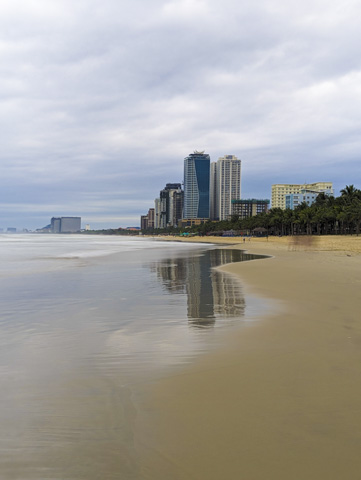
Although Da Nang isn’t really a big hitting tourist destination we actually really liked the feel of the city and there are a few tours that run from here but unfortunately for us, not during Tet. What it does have is a pretty lovely beach but as you can see from the picture, it wasn’t really beach weather.
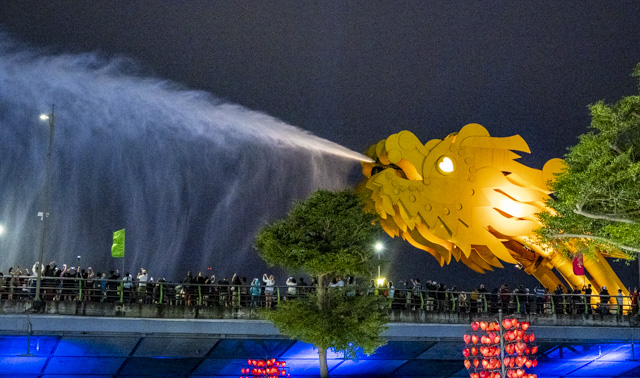
After our brief stop in De Nang we headed to the stunningly beautiful and uber touristy town of Hoi An, which is about 30 minutes away by taxi.
Hoi An is an historic port town that dates back to the 2nd century when it was a busy seaport of the Champa kingdom. The town avoided damage during the Vietnam/American war and as a result there are over 800 historic buildings, meaning the town looks much as it has for hundreds of years.

Unfortunately the Japanese covered bridge, which is one of the top attractions, is being refurbished and has been completely deconstructed but there were still plenty of temples and historic buildings to wander around and admire.

Just a few metres from our homestay was a street which became a vibrant night market with lots of vendors selling all sorts of food from frogs on sticks to Vietnamese pizza (which are nothing like pizza but are absolutely delicious).

In addition to foreign tourists, the town of Hoi An is really popular with Vietnamese tourists and therefore, we assume because of the Tet National Holiday, the volume of tourists was unbelievable. Think Venice and then double or triple the numbers. Early in the morning it was really pleasant with not many people around but by about 5pm the streets were packed and it was difficult to walk around.

Many of these tourists (when not taking selfies in front of everything and anything) were taking small boats up and down the river, particularly at dusk when they would light small paper lanterns to float them down the river.

Hoi An is about 3km from An Bang beach, and when we woke up one day to a warm sunny day we decided to escape the hustle and bustle of town and head to the beach, only to find that everyone else (well, the Westerners) had the same idea! However, the crowds were clustered around a bunch of bars and restaurants with sun loungers and after a little walk along the beach the crowds fizzled out and we were treated to an empty sandy beach that stretched as far as the eye could see.

From Hoi An we also arranged a car to take us to the My Son ruins. It takes about an hour of driving through the countryside to get there from Hoi An.

My Son, meaning Beautiful Mountain, is the site of Vietnam’s biggest Cham remains. My Son was a religious centre and was occupied between the 4th and 13th centuries. Unfortunately many of the temples were destroyed by American bombing. At one stage the tops of the buildings were covered with a layer of gold but this is all gone now.

Today the Cham people remain a sizeable ethnic minority within Vietnam with around 140,000 people.
We have been really enjoying the food in Vietnam and each of the regions has its own speciality. In Hoi An there is a dish called White Rose which we absolutely loved. These are dumplings that are only made by one family who were Chinese immigrants and have been making White Rose for 130 years and only in Hoi An. They distribute the dumplings to many restaurants in town.

Our next port of call was to be Hue (pronounced H-way) which is about 120km North of Hoi An. The most interesting route is to drive over the Hai Van pass.

Through the owner of our homestay we arranged to do an easy rider trip (which means being a passenger on the back of a motorbike) across the Hai Van Pass.
We were picked up in the morning and rode back towards Da Nang. The bikes were actually really comfortable and the views were great.

Our first port of call were the marble mountains just outside Da Nang. These are a series of five marble hillocks which are topped by temples. There is an elevator to reach the top but there are still lots of steps when you reach the top to get between different areas. There are also a number of caves around the summits which have been converted into temples.

From here we looped through Danang and along the coast until we started climbing up the Hai Van pass. The pass is only 496m high but Hai Van means Sea Cloud which means that it is often buried in dense cloud. And so it proved for us. We stopped at a viewpoint but all we could see was white with the occasional glimpse of the rugged coast beyond.

After stopping for lunch at a lovely fish restaurant on the beach we headed along the coast towards Hue. Stopping to learn about the fishermen who live in the Phu Loc Lagoon area.
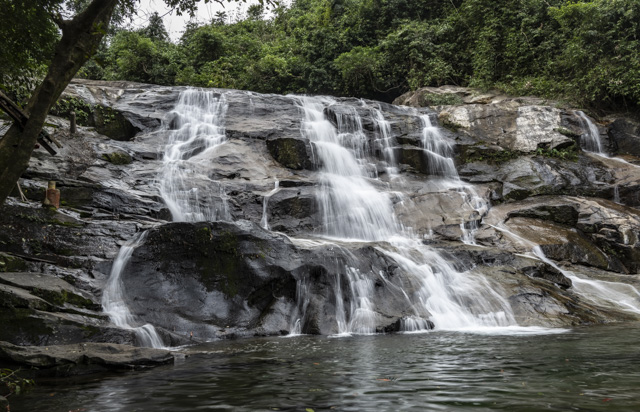
The weather this side of the pass was completely different and much better than it had been in the South so we next visited a waterfall for a refreshing swim.
We were now getting close to Hue and detoured through the rice fields on narrow dirt tracks and paths between the paddies before eventually entering the city and finding our hotel.

It had been a really good day despite the weather so we asked our guides whether we could book them the next day for a tour of the area around Hue, which they were happy to do.
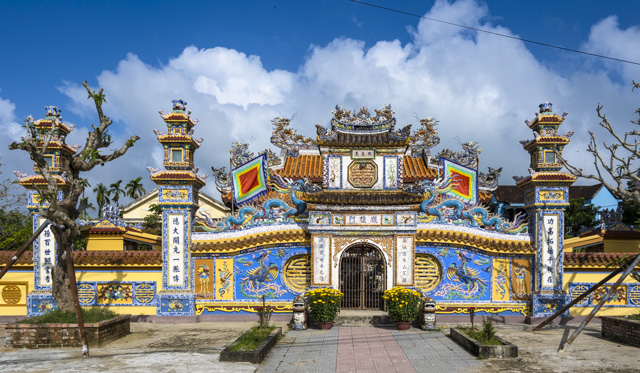
Early the next morning our guides/drivers turned up again and we were off to explore Hue, which is a much bigger city than Hoi An. Hue is sited on the Perfume river and was a centre for trading in the past with access from the sea and from inland. Traders came from all round the world to do business here. It was also the capital of Vietnam between 1802 and 1945 as the home of the Nguyen dynasty emperors.
For the morning we headed out of the city to visit a number of tombs of the emperors of Hue which are in the vicinity of the city.
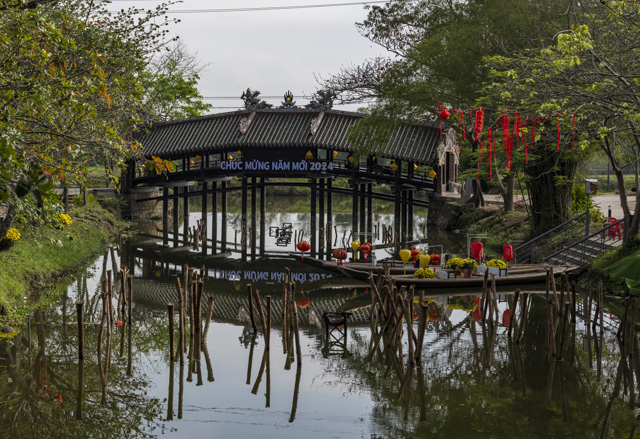
Before starting with the temples we headed to the Thanh Toan Japanese footbridge (built in 1776) which is in a small village just outside Hue. There was a local market just next to the bridge and we stopped in a little unmarked restaurant for a breakfast of soy eggs in a sizzling skillet which was delicious.
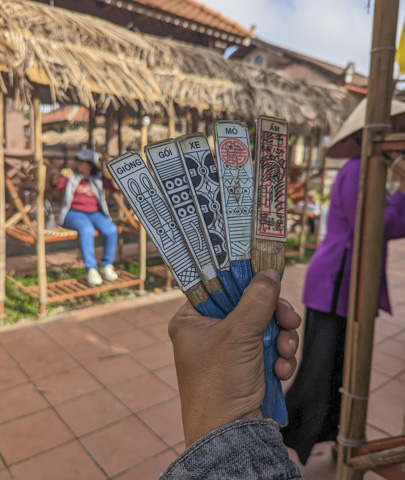
While we were looking at the bridge one of our drivers took part in a gambling game which was taking place near the bridge. It involved wooden battens with different drawings on which needed to be matched. The gamesmaster was a woman who would chant until someone claimed a match. It was all very mystifying.

The first tomb we visited was the Tomb of Khai Dinh, built into the hillside and accessed by a grand staircase. Khai Dinh was the penultimate emperor of Vietnam and died in 1925. The interior of the tomb is decorated with a colourful ceramic mosaic.

Next was the Tomb of Tu Duc which was completed in 1867. This has a lake just inside the entrance with a small island and a beautiful pagoda overlooking the lake. In the grounds of the complex are a number of tombs.

As we rode between destinations we wound our way through a valley of gravestones. This ‘cemetery’ filled an entire valley and was at least 4kms long. We have never seen anything like it before, it was absolutely filled with small tombs and gravestones and quite a sight.

The next stop was a break from the history of the area as we visited an abandoned water park. This is due for demolition soon and the slides that used to be here have already gone.

Around lunchtime we rode back towards Hue, via a viewpoint over the perfume river where old American bunkers from the war are gradually crumbling, to a local restaurant down a back street where we were treated to some fantastic local food and were the only westerners in a very busy restaurant.

The biggest attraction in Hue is the Imperial Citadel and we had saved this for last, although it is huge. This is a city within a city and was built between 1804 and 1833. The whole citadel is surrounded by thick walls (2m thick and 10km long) and a moat (30m wide) so is well defended.

The centre of the citadel is the Purple Forbidden City which was the reserved solely for the emperor and his concubines. The only servants allowed here were eunuchs who wouldn’t be interested in the concubines !

The stunning Kien Trung palace has recently been opened after being fully restored following its destruction in 1947 during the Indochina wars. This was the most recent and ornate of the palaces in the Citadel and was used by the last two emperors of the dynasty.

We managed to see the highlights of the Citadel but its sheer size defeated us and after a long day we were absolutely exhausted by the time we found our way out. We had seen temples, palaces, gardens and even a theatre in this vast site. It would definitely reward multiple visits. But this was the end of the day as we made our way back to our hotel (the themed Scarlet O’Hara hotel!).

We said goodbye to our drivers and guides from the last two days – HueToGoTours– who were absolutely excellent and we would thoroughly recommend.
Ho Chi Minh (or is it Saigon?) and the trials of Tet
Ho Chi Minh City may not be the capital of Vietnam but it is its biggest and most prosperous city, with a population of 9.5 million. Before 1976 HCMC was called Saigon and many Vietnamese still refer to it by the old name. After some discreet enquires of the locals it seems that either name is acceptable.
We arrived in Vietnam in the early evening but fortunately a cab into the middle of town was only 45 minutes. We had a great taxi driver who told us all the places we should visit and the foods we should eat – all while showing us pictures on his mobile phone and driving at the same time.

Our hotel was definitely not one of the best on our trip with no window but at least it was quiet at night and situated in the central District 1 near to all the tourist must sees.

We had booked our trip to Vietnam before learning about the Tet holiday which was due to start soon after we arrived. Tet is the biggest holiday of the year in Vietnam and is the celebration of the Chinese New Year. A lot of businesses shut for a week around this time and most of the growing Vietnamese middle class go on holiday.
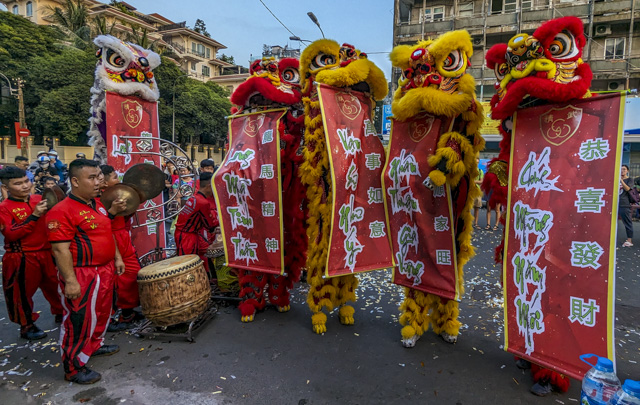
The upshot of Tet was that lots of tours weren’t running and many shops, restaurants and bars were closed. There were also huge numbers of Vietnamese tourists around making some places unbelievably crowded. Not the best for our first week in Vietnam.

On the plus side however, there were huge numbers of decorations around the city, masses of flowers everywhere (the Vietnamese love their flowers) and there was a real party atmosphere in the lead up to the celebrations, which are usually spent with their families. A massive open air flower market opened up in District 1 to provide flowers for people’s Tet decorations.

A major road in the centre of District 1 had been pedestrianised and decorated with flowers and dragons and there were signs everywhere saying “Chuc Mung Nam Moi” or “Happy New Year”.

Despite all of this we did manage to see some of the city. Our first port of call was the Independence Palace, which served as the seat of government between 1962, when it was built and 1975 when the puppet government in the South was overthrown by North Vietnamese forces to conclude the American war. (Unsurprisingly the war with America that is called the Vietnam war in the West is referred to as the American war in Vietnam).

The building is in a Modernist style but the interior has been preserved in a gloriously 70’s style !
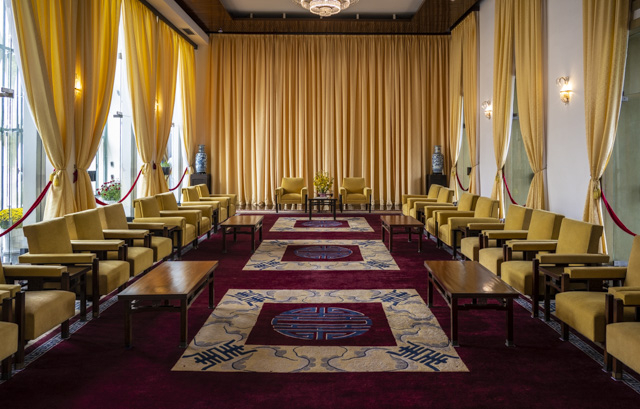
It feels like it could be a set for a Bond film and even has an underground bomb shelter with communication equipment from the 70’s and a situation room with maps of troop movements from the war.
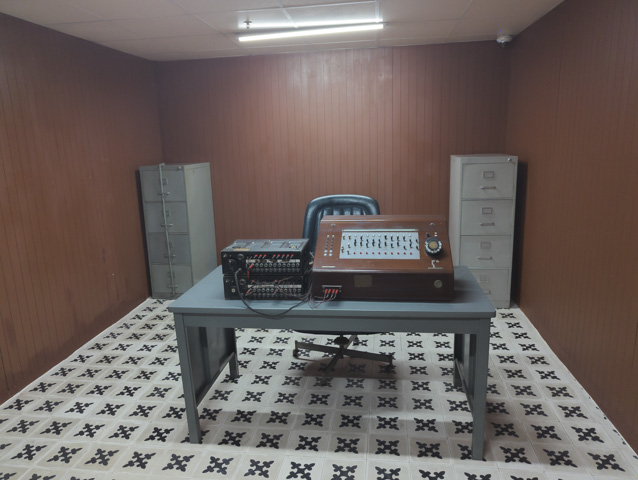
After visiting the Palace our next stop was the highly thought provoking War Remnants Museum. This museum showcases the Vietnamese side of the American war and focuses on the atrocities committed by the American forces during the war. It also has a wing dedicated to the prison systems in the South of Vietnam where the North Vietnamese soldiers were incarcerated and the various tortures that were employed.

When trying to understand history it is important to realise that every source of information is biased depending on who is telling the story and there were clearly atrocities on both sides. However, the facts of the American war are horrendous with over 7.5million tons of bombs dropped on Vietnam by the Americans and their allies and 13 million gallons of Agent Orange (a herbicide designed to clear forested areas) sprayed in Vietnam leading to devastation of the environment and cancers, birth defects and neurological problems in the population for years to come.

This is a sobering as well as thought-provoking museum and well worth a visit.
In the evening we jumped on a bus tour of the city which drove us around and gave us a great view of the skyline of Saigon. It’s a big modern city with lots of skyscrapers. At night they are all lit up with many having lightshows on their exteriors.

One of the most popular tours from Ho Chi Minh is to visit the Cu Chi tunnels. These are a preserved example of the tunnels that the Viet Cong lived in and used as a base to strike against American troops in the war.
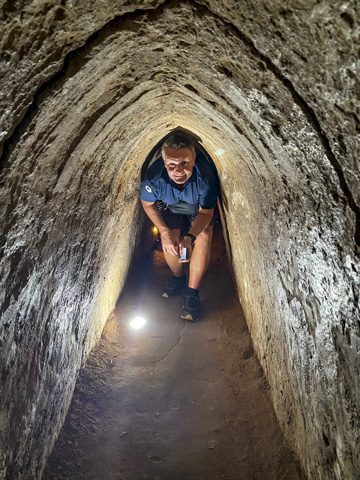
The half day trip to visit them is rounded out with a stop-off at an arts and crafts factory, providing work to those born with disabilities due to Agent Orange, and rather ironically, at the other end of the scale, a shooting range where you can shoot, among others, ak-47s and M16s.
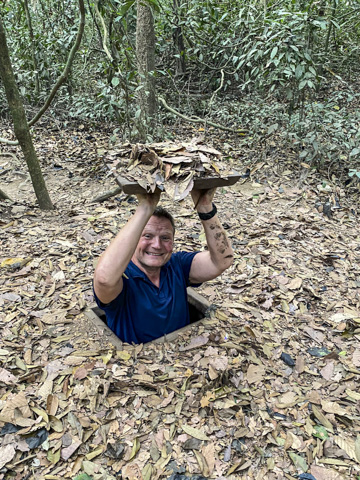
The tunnels that are open to tourists have been stabilised and enlarged for our western bodies to get down them. The original tunnels were absolutely tiny and with the heat and humidity in this part of the world must have been incredibly uncomfortable.

The whole tunnel complex was incredibly well hidden with ventilation pipes hidden in fake termite mounds. The area was also heavily booby trapped with traps designed to severely injure the American troops.

The tour was an interesting history lesson and a good insight into how horrific the war must have been for both sides.

From Ho Chi Minh we also did a two day trip out to the Mekong delta which although only a 100km away is a good three hour drive on the congested roads.

It was a really interesting trip that gave us an insight into the way of life in the delta which is of course based around the water ways which are branching with big and small channels.

Fishing is obviously a very important activity in this area and we visited a floating fish farm which had a number of pens with both fish for consumption and ornamentals. All of this in the middle of one of the biggest channels of the Mekong Delta.

We also visited some of the narrower waterways and took a boat trip in a traditional hand paddled boat but for me, the most interesting part of the tour, was the trip to the Cai Rang floating market. This is close to the town of Can Tho and is different from the floating market we visited in Thailand as it’s a wholesale market.

On each of the boats a pole with a sample of the goods that they sell is raised aloft to show what they deal in. Each of the boats tends to deal in only one type of product.

The action in the market happens early in the morning and we visited first thing but even then it was beginning to wind down. It all starts at 3 or 4am so by 7am it’s almost over but we got a glimpse of the action and really enjoyed the experience.

Siem Reap – A Templetastic Time
We arrived at Siem Reap’s new international airport quite late but it was fairly easy to get a taxi for the 1 hour journey to town. The airport has only been open a couple of months and replaces one that was only 7km from town. The locals are not so happy with the new airport as there are fairly significant fees for using the new road to the airport and for parking.
Hotels in Siem Reap are great value and we had a lovely room facing onto a pool complete with wet bar. Given how hot it is in this part of the world we would use this pool a lot.

The reason that everyone comes to Siem Reap is for the Angkor ruins that consist of 100’s of temples spread over a huge area of 1000sq km’s. This was the capital of the Khmer civilization and is considered to be the site of the largest pre-industrialised city in the world with a population of up to 1 million people.
The city of Angkor flourished between the 9th and 15th centuries. Since being named a world heritage site in 1993 there has been considerable preservation work carried out on the site, involving investment from a range of countries but using Cambodian workers, to preserve and restore many of the temples.

The Temple complexes start about 5km from town and the best way to access them is to hire a driver for the day. It’s possible to hire a car but we chose the option of a Tuk Tuk. The Tuk Tuk’s in Siam Reap are a bit different from the standard type. They consist of a motorbike with a connector (a bit like a semi-truck) to a carriage which holds up to four people. They are definitely more comfortable than a standard Tuk Tuk and we only paid US$18 for a day hire.
There are two standard tours around the Siam Reap temples: The Big loop and the Small loop. They both travel around a similar area but visit different temples. The big loop actually visits smaller temples so takes less time, although it has marginally more driving.
We decided to spend three days visiting the temples so did the small loop, the big loop and then a bespoke day visiting temples that weren’t on the two loops.

Angkor Wat is the biggest temple and the one that everyone has heard off. This means that it is by far the busiest of all the temples. It is in fact considered the largest religious structure in the world.
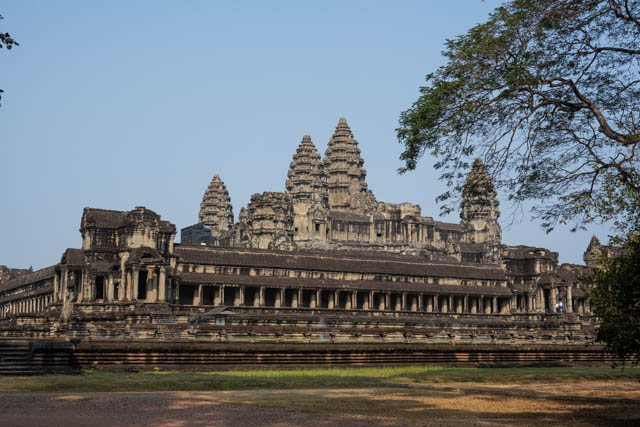
Angkor Wat was built in the 12th century as a Hindu temple dedicated to Vishnu by King Suryavarman II. However over time it was converted into a Buddhist temple. There is a large moat surrounding the complex which is over 5km long and 200m wide. Inside the moat is a gatehouse and wall and then inside this is the temple complex proper (a 350m walk inside).

I decided to come to Angkor Wat to watch the sunrise, as this can be really spectacular. Unfortunately on this day the sunrise was more a gentle lightening of the sky with no particular stunning colours and of course you are sharing the experience with all the other like-minded tourists. It reminded me a bit of when we watched sunrise at Machu Picchu as it was similarly crowded. Just you and 1000 other people! If you want to pick and choose your position for photos you need to arrive in the pitch dark at least an hour before sunrise and then you’ll have no chance to reposition during sunrise as it is just way too busy.

Actually my favourite bit of Angkor Wat was one of the gatehouses (the South) which contains a small Buddhist shrine. This was seemingly off the beaten track as there were no other tourists there – only a handful of locals visiting the shrine and there was a group of monkeys crawling over the building – trying to get at the food offerings made at the shrine.

Definitely take some water when walking around Angkor Wat as its so big – the walk from the taxi/ Tuk Tuk drop off point to the central temple complex is 1 km itself.
After leaving Angkor Wat we headed towards the walled city of Angkor Thom which was the capital of the Khmer empire and was built in the 12th century. The city covers 9km2 and between 80k and 150k people lived there at its height.

The city was abandoned sometime before the start of the 17th century although it is not known exactly when.
At the centre of the city is the temple of Bayon. This temple is striking for its towers decorated on all four sides by the smiling face of Buddha (said to have been modelled on the face of King Jayavarman VII). In all, there are 216 faces carved into the temple.

On the outside walls of the temple are detailed bas-reliefs of lots of different scenes including battles and armies. There is some debate on the meaning of many of these scenes.

Once inside this temple feels claustrophobic and densely packed in real contrast to the sprawling nature of Angkor Wat. This made it one of our favourite temples to visit.

In the area around Bayon there are a number of other temples in walking distance. These are all less visited as they are not on the Big or Little circuits.

Baphuon is a big blocky temple with a long raised walkway to approach it.

You can climb this temple but like all of the temples in the area it just isn’t quite high enough to see over the tops of the surrounding trees.

In the same area are the two impressively carved terraces: the Elephant Terrace and the Terrace of the Leper King. It is not known who the Leper King actually was although it is suspected it might have been Yasovarman I.

After leaving the city of Angkor Thom we visited a lot of other temples:
Preah Khan
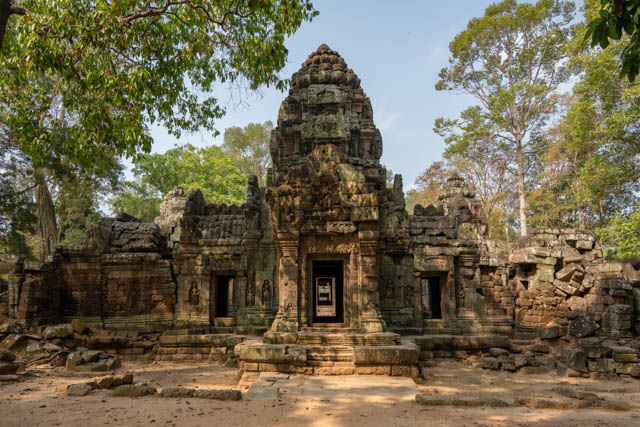
Banteay Prei
Neak Pean

Ta Som
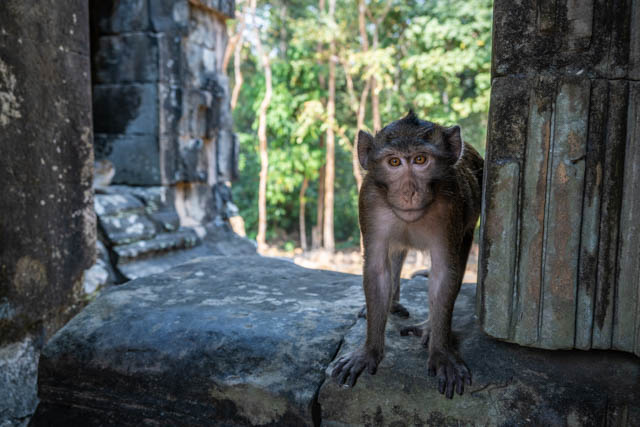
Eastern Mebon
Ta Prohm
Pre Rup

Banteay Samre
Srah Seang
Banteay Kdei
That’s an awful lot of temples but there is a lot of variety in there. Some are big like Ta Prohm which is a kilometre from one gate to the other side and some like Neak Pean are very small (It’s a small temple in a pond on an island). Some are very tall like Eastern Mebon and some are single story like Preah Khan. And they are all in different levels of being swallowed by the jungle, reclaimed and restored.
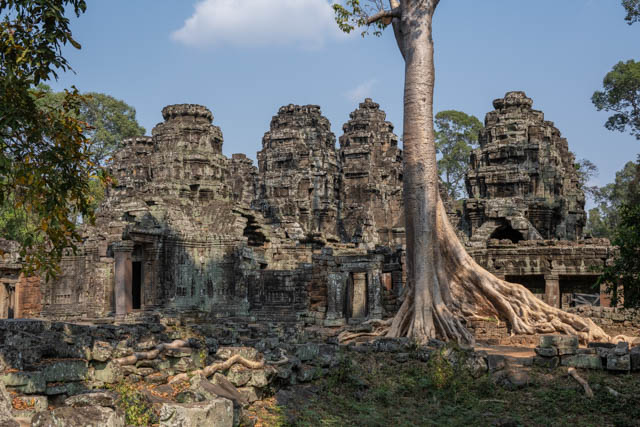
Ta Prohm is probably the most famous of the temples other than Angkor Wat. Its other name is the Tomb Raider temple and it was featured in the tomb raider film starring Angelina Jolie. Construction on Ta Prohm started in 1186 by King Jayavarman VII.

It was abandoned In the 15th century and the jungle took over until restoration works started in the early 21st century. Since then the restoration has been sensitive to the fusion of ruin and Jungle leaving the very picturesque remains today where large trees still grow atop many of the ruins.

The town of Siem Reap itself is built around wide streets and is fairly quiet. There are very few cars, as these are expensive, and motorbikes have been adapted to many different roles. We’ve never seen such a variety. My favourite was definitely a florist that must have been more than 5m long.

At the centre of town is the lively Pub Street which has the bright lights and music of places like Patong but none of the seediness. It was actually quite a nice place to wander around and have a cheap beer. The best bit was that a beer could be had for as little as USD 0.5.

Right next to the Pub Street area is the local market which has the normal tourist tat around the outskirts but inside are the food sellers for the locals where women perch on top of their produce tables offering there wares to anyone that passes by.

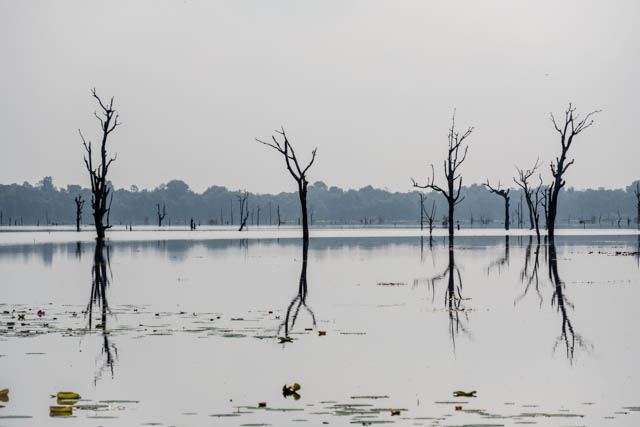
We really enjoyed our time in Siem Reap and were really glad to have a few days to enjoy it. Most people seem to fly in and fly out with only enough time to do a couple of days at the temples. This can be exhausting because of the heat and lack of shade in many of the ruins. We took a day off between our visits and enjoyed the pool (and pool bar) which made us much more enthusiastic when we visited the temples.
Our time in Cambodia was over for this visit but we’ve seen enough of the country to want to come back and travel more widely next time. For now we were heading to Vietnam and the sweltering heat of Ho Chi Minh City.
Bangkok Nights (and Days)
Our next destination after Thailand is Cambodia but in order to get there we had to transit through Bangkok. Rather than just fly straight through we decided to take a couple of days to see the sights but we didn’t allow too long as Bangkok has a reputation as smelly, busy and not that interesting.
I had been to Bangkok in the nineties at the start of a round the world trip and it was my first time travelling out of Europe. I had found it meltingly hot, overwhelming and had a pretty miserable time of it. Fortunately the trip picked up when I reached my next destination of New Zealand.

Being a lot older and a little wiser I wanted to give Bangkok another try and it was a massive surprise – in a good way. We stayed in the Khao San road area, where I had stayed last time. Gone are the all night full volume electro beats, the harassing tuk tuk drivers and the massive culture shock. I think 30 years of travel experience has probably helped but the area itself has also changed a lot, having been cleaned up and gentrified.
The time of year also probably helped, although it is hot the crippling humidity of my last summer visit just isn’t present.

Day 1 of our plan was to visit the Grand Palace and Wat Pho, which are close to each other and only a 10 minute Tuk Tuk ride from where we were staying.
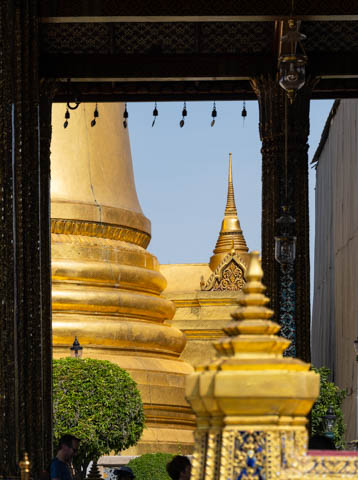
The Grand Palace is stunning but it was absolutely swarming with people making any serenity hard to find. The Grand Palace has been the official residence of the Kings of Siam (latterly Thailand) since 1782. The Kings, his court and the royal government were sited here until 1925 but it is still used for official functions.
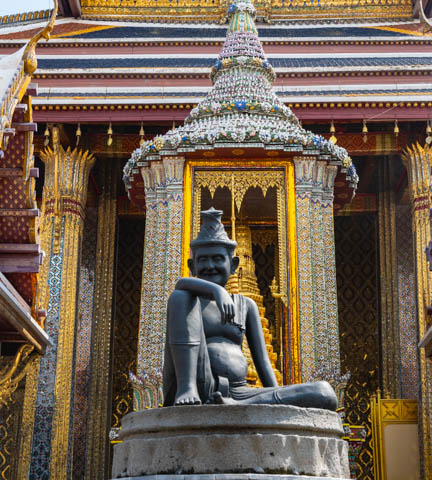
The Grand Palace consists of a number of separate buildings spread over a large area, 218,000 sq meters and is enclosed by a wall. However there is an inner court area which is open to the public that contains most of the important buildings.
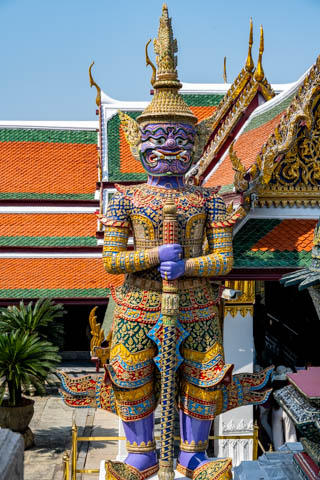
This includes the temple of the Emerald Buddha or to give it its proper name Wat Phra Sri Rattanasasadaram. This is the royal chapel and at its centre is a figurine of the Buddha made from green jade, and clothed in raiment’s of gold and diamonds.

Surrounding the inner courtyard is a covered walkway which is painted with a classic Thai story of Good and Evil, The Ramakien. In all, there are over 2km of murals depicted. The first paintings were started in 1783 but they have been constantly touched up and indeed when we visited there were several painters working on restoring the murals.

Part of the ticket to the Grand Palace included a free traditional dance show, so on leaving the Palace we jumped into n a small shuttle bus to take us to the theatre for the show.

The show was very good, culminating in a dance story of how Hanuman conquered a Sea Nymph to allow a bridge to be build which was well-told with plenty of audience interaction.

Our next stop in Bangkok was Wat Pho or to give it is proper name, Wat Phra Chetuphon Wimon Mangkhalaram Rajwaramahawihan.
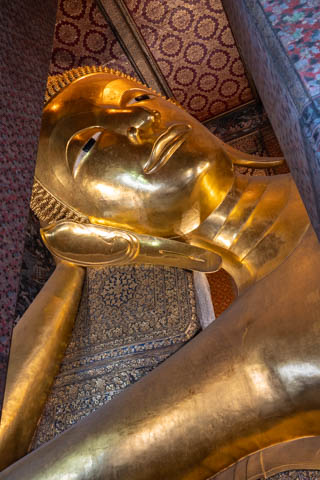
This is the home of the massive Reclining Buddha which is 15m high and 46m long.
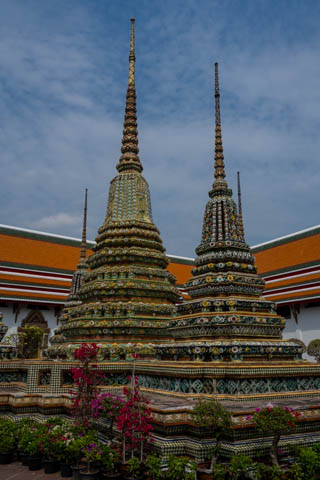
Wat Pho is one of the largest, oldest and most sacred temples in Thailand. It consists of many buildings in the large compound and some really large Chedis (tower structures) know as the Giants.

While in Bangkok we also wanted to visit a floating market. The best floating markets are outside the city so we signed up for a tour.
We were picked up at 7am in a small minibus and driven for around 90 minutes, through terrible traffic, to the first stop.

This was the train market or the Maeklong Railway market. This is a relatively small market but a fairly unusual one in that the market stalls are setup either side of a train track. The market very much encroaches on the tracks meaning that when a train comes along (4 times a day) the stall holders have to pack up their stalls to make room for the train to pass through.
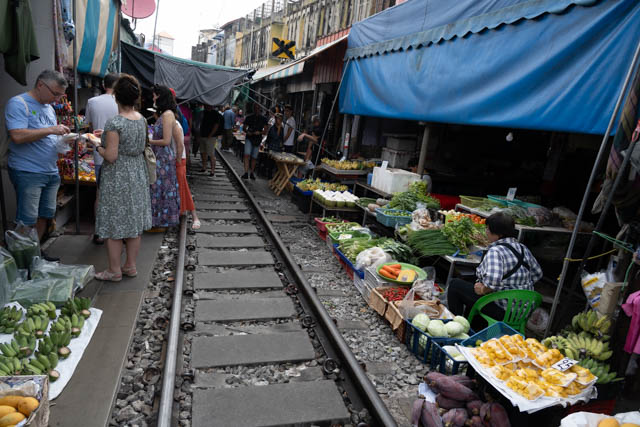
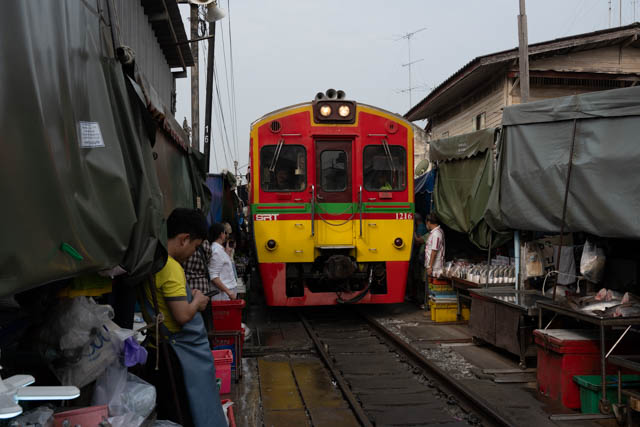
Once the train has gone past the market comes back to life and in a couple of minutes the stalls are open as if the train had never existed.
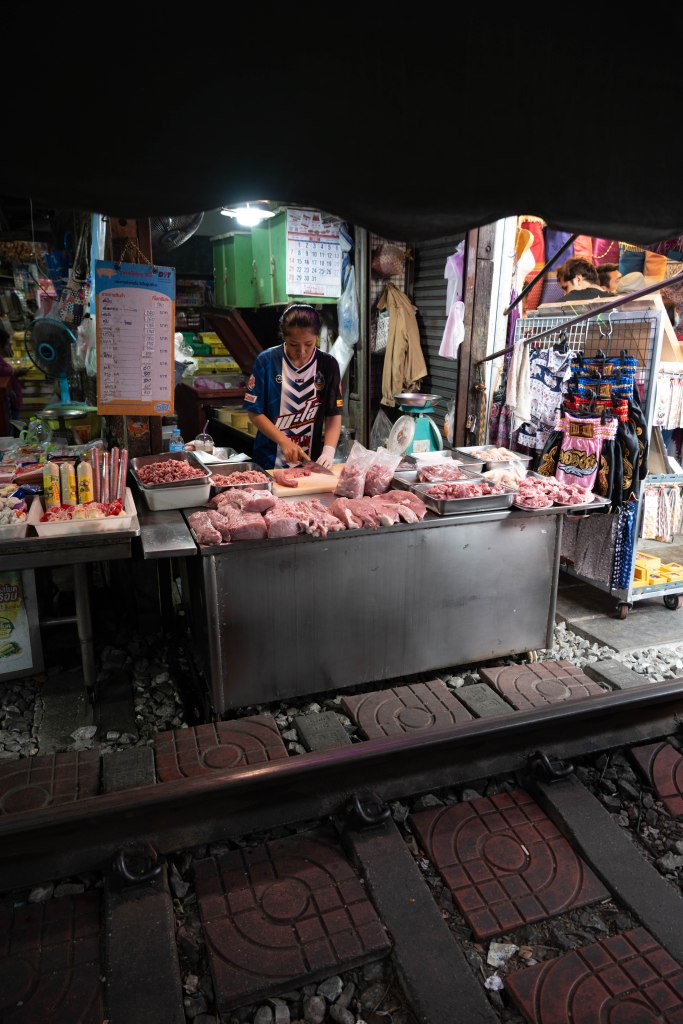
This was a pretty quick stop on the tour as we arrived 30 minutes before a train was due to arrive and left 15 minutes after the train passed through but is was definitely an interesting and enjoyable detour.
Back on the minibus for another 20 minutes or so and we had reached a small dock by a canal where we were transferred by longtail boat to the floating market. We flew through the canals and rivers, the engine of the longtail screaming until we arrived at the dock for the Damnoen Saduak Floating Market.

The market is split between areas that can be accessed from the banks of the canals and areas that can only be accessed from the water. The canals themselves were chaotic with lots of boats, some longtails with noisy engines but mostly row boats.

We decided to jump in a small row boat to get a tour around the market. After we had set off into the chaos of the main channel we very quickly passed a boat with a lady selling drinks. A quick beer for the journey was procured !
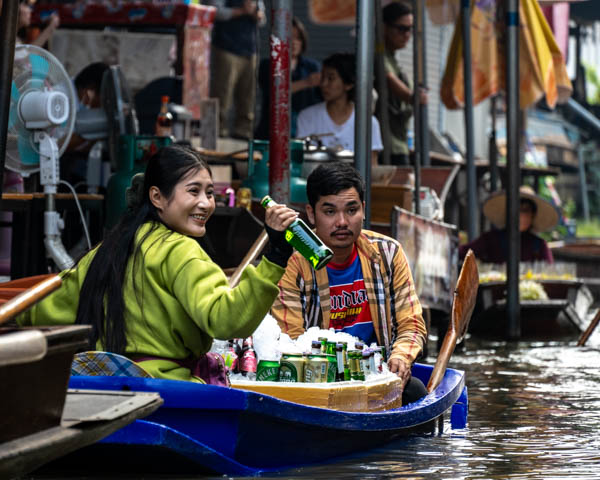
We slowly moved past all sorts of stalls and small boats where the stall/boat holders were managing to produce full meals from tiny woks in their floating kitchens.

Some of the stall holders would deploy long hooks to pull the boats in, enabling them to hawk their wares more easily.

After our boat trip was finished we walked around the on-land portion of the market and bought some lunch from one of the tiny boats. I had ‘Boat Noodles’ which is a traditional dish from Bangkok’s canals. It was really rich tasting being seasoned with pig blood and it was pretty fiery !

Unfortunately our time at the market came to a close too soon and we had a 2 hour, very bouncy and uncomfortable minibus ride back to the centre of Bangkok.
On the morning of our last day, we had a couple of hours to kill before heading to the airport for our flight to Cambodia so we decided to take a boat ride down the Chao Praya river. This is a major thoroughway with lots of commuter boats heading up and down the river.
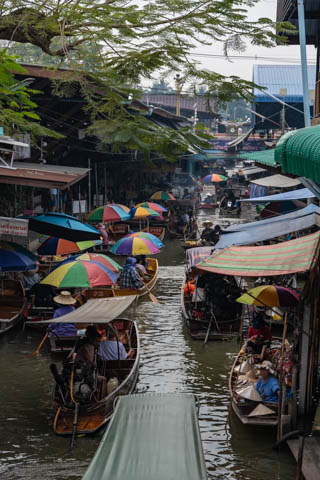
We jumped on one boat and enjoyed a trip of a few kilometers up the river to Chinatown. A quick explore of Chinatown and then we were back on a boat to take us back to our hotel.

Unfortunately our quick trip to Bangkok was over. We actually wished we had more time there to continue exploring. I am so glad I decided to give Bangkok another chance and we are pretty sure we will be back but for now, it is on to the next destination, Siem Reap in Cambodia.
I have set up a FromAtoB instagram account for 2024 (fromatob2024) and have been doing a picture a day from our travels. If you are interested head on over to Instagram and do a search for “fromatob2024”.
Phi Phi
The Phi Phi Islands are a small collection of islands about 45 km’s Southwest of Phuket. It takes around 2 hours to get there by ferry or 1 hour by speedboat. We booked the tickets online at www.phuketferry.com and decided to take the budget option of the ferry. The advantage of this (in addition to the price), is more space to move around and some outside space, although the seating is airline like. We paid around £45 for two return tickets.
Getting from Phuket Town to Rassada Pier, where the boats to Phi Phi depart from, is a very easy 10 minute taxi ride. We have been using Grab for taxis, the Asian Uber, and it works well.
The pier was a bit chaotic but after showing our tickets on the phone, we were given stickers to wear and sent to the gate inside. Before the gate however, we had to check-in with our “agent” which involved writing our names on a list and receiving a paper ticket.

Once through the turnstile and onto the pier it’s a simple matter of clambering over one ferry to get to the next one across.
The journey was fine with flat water and before long we were pulling into the pier at Phi Phi Don Island. There is a small tourist tax upon arrival and once you are paid up and off the pier you land directly into the narrow streets of the islands main town, which provides welcome relief from the blazing sun.
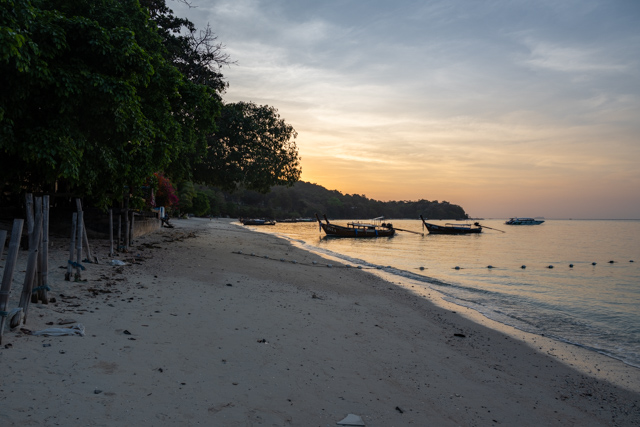
Fortunately our hotel, the curiously named Chukit Resort, is easy to find, just a 700m walk down the coastline from the port and Ton Sai pier and we are soon checked in and ready to explore the island.
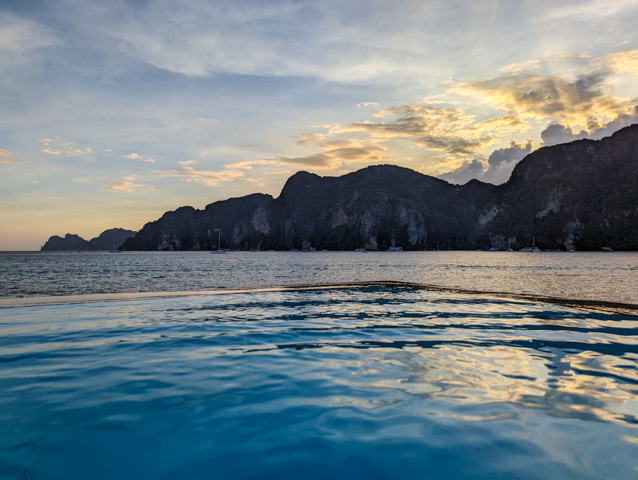
First stop is the hotel’s infinity pool looking out over the ocean, the only one on this side and maybe the whole island. Not bad for a budget hotel!

The side of the island we are on is the busier side with lots of longtail boats coming and going and the biggest concentration of shops, restaurants and hotels.
I didn’t waste a lot of time signing up to go diving the next day with an outfit called PKT divers, but this was only one of at least a dozen dive operators that I saw. I think the majority of divers in Phi Phi are doing courses or have just learnt as the operator seemed to want to do everything for you.

We left the dive shop for a five minute walk to the dock where the boat was moored. All the dive kit was already set up on tanks and the guides even set up the weight belts for you. I’m not sure that the dive guide was very impressed when I took the kit apart and put it back together again to make sure it was ok. There was only 180 bar in my tank which is apparently fine!

It was only about a 30 minute ride to the first dive site which was in a small bay on an uninhabited island in the Phi Phi group of islands. As we were arriving we had a very minimal briefing which was basically follow me. I was to be diving with two girls who had only done a handful of dives and they were to buddy up so I was loosely buddied up with the Spanish dive guide who had only been in Thailand for a week.

We entered the water with a giant stride and after meeting up on the surface descended to the bottom. Neither a depth gauge or a timing device was offered as part of the equipment hire so following the guide, who had a computer, was pretty essential. We made are way along a broken reef with relatively sparse coral but large schools of small fish. The visibility was ok but the biodiversity was pretty limited and there wasn’t much macro life in evidence.
After just over 30 minutes one of the two girls had run out of air so it was time to surface. I checked my gauge and still had over 100 bar left so this was disappointing.

The boat was around 100m away from the island and we had to swim to it before taking off our fins and climbing up a ladder to the back deck.
After quickly de-kitting and changing tanks, despite the guide suggesting he would do it, there was time for a short surface interval as the boat moved to another island for the 2nd dive.

This time there was no briefing at all but the dive was much the same, although with a slightly nicer wall. Again at just after 30 minutes the dive was over as one of the girls was out of air.
There was a quick 20 minute run back to the dock and the diving was over.

Phi Phi is meant to be some of the better diving in Thailand and on this evidence I wouldn’t dive in Thailand again as it was very average. The operator, although mostly safe, had rented poor quality gear (one of the girls inflators barely worked and my gauge was fluttering the whole time), didn’t deliver on their promise to match me with similarly experienced divers to ensure better dive times and particularly for the novice divers, did not deliver adequate briefings.

The other side of the island from our hotel is the main beach, called Loh Dalum beach. This is a lovely beach with lots of beach bars and even a couple of clubs. At one end is the Ibiza Beach Club which has a big swimming pool and holds big pool parties.

The beach although lovely has very shallow water and its very difficult to go swimming as you have to wade out a long way to find deep enough water.

Perhaps the nicest beach on the island, that I saw, is Long Beach. This is about a 30 minute walk from Ton Sai Pier but is a long sandy beach with less people than Loh Dalum beach. However the water is still shallow and not brilliant for swimming.

I walked back across the island and via a viewpoint of the island from Long Beach. The way up from the main town is a super steep flight of stairs and I’m very glad that I’d climbed up the back way which was longer but much easier.

We were only on Phi Phi for a few days but it’s a really nice island. It’s very busy and there were a hell of a lot of people around. It really has a feel of somewhere that would have been very special 20 years ago but is a bit well known now.

The journey back to the mainland was easy enough although did involve a 20 minute queue in the strong sunshine without shade to check-in, which was a bit unpleasant. We had a slightly smaller boat going back which had a bit less space on board but it was fine.

We arrived back in Phuket town and jumped in a shuttle bus to our next destination, Kata Beach.
Flying East for Winter
While birds migrate South for the winter, we decided to fly South East in order to avoid the Winter season this year. Last year we wintered in the UK Lake District and the French Alps which meant we had our fair share of snow, ice and cold, so this year we wanted some warmth and sunshine.
First stop on our trip is Thailand and the holiday island of Phuket. After travelling all of last year we wanted a few weeks of relaxation and sunshine before heading back into full travel mode for 2024.

We flew from London Heathrow to Phuket on Etihad Airways with a stopover in Abu Dhabi on the way. We were only on the ground for a couple of hours which meant by the time you get off one plane and have to be at the gate to board the next, there was very little time to explore the new terminal, which only opened in November. It was nice and spacious but Singapore doesn’t have much to fear in terms of competition for the best airport in the world.
The flight on Etihad was very good with surprisingly good food, new airplanes and a decent amount of space.
We landed in Phuket early in the morning and after tackling the big queue for immigration we were through into Thailand. Rightly or wrongly we booked a cab from the transport window right opposite the arrivals and were given a fixed price of ฿650 (£14.50) which seemed reasonable to take us to Phuket Town where we had booked a hotel for a few nights.
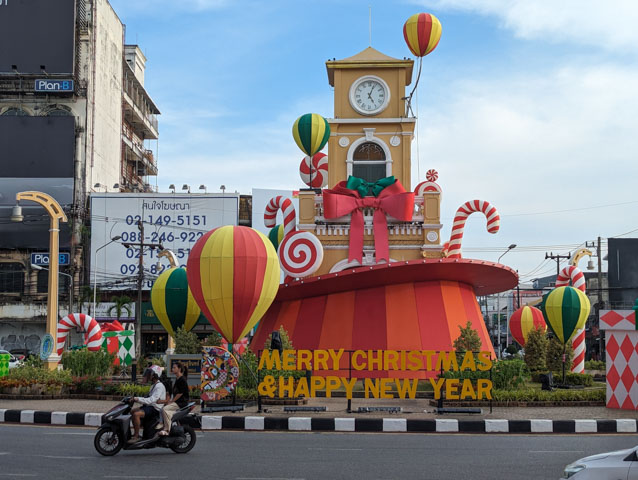
Our hotel was about 200m from the main streets of the old town but far enough away to be close to some good local, non-touristy restaurants.
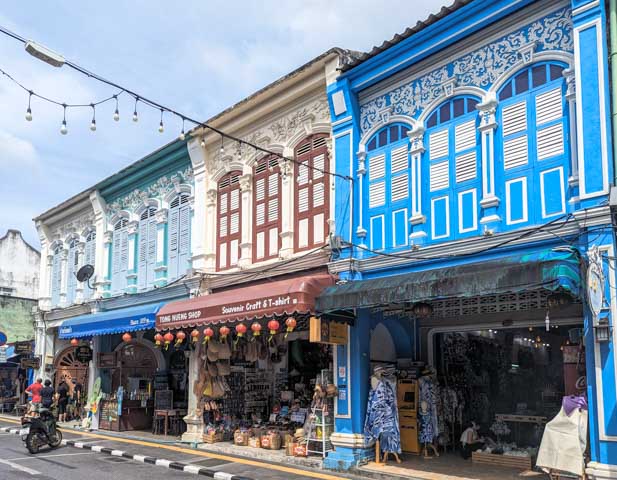
The old town of Phuket is composed of two main streets and a couple of cross roads so is pretty compact. The buildings in the old town are built in the Sino-Portuguese style which gives it a very colonial feel.
The streets are very busy and the buildings are an eclectic mix of cafes, bars, tourist shops and local shops. Instagram culture has very much taken hold with several spots swamped by selfie snapping tourists.

The streets around the old town are much less busy and there are hundreds of local restaurants with all types of specialities. Perhaps the strangest we tried is the puddings only restaurant that served very little of what I would describe as familiar food. We tried a honey soaked toast with ice cream dish which was really nice and definitely the tamest option on the menu.

What we quickly discovered is that Western food is more expensive but if you stick with Thai Food you can eat very cheaply. The going rate for a Phad Thai is around 80-100THB (approx. £2).

On Sunday nights the old town is pedestrianised for a large market called Phuket Walking Street. Three roads are taken over by market stalls which are split around 50:50 between food stalls and stalls selling souvenirs to tourists.

There is also entertainment with a selection of singers and bands spread around the streets.

We took the opportunity to try some of the street food and discovered that fried squid eggs are delicious. If there is one thing you do need to be careful about in Thailand though it is the hot dips and sauces as these can be blow-your-head-off hot.

A short walk from the heart of Phuket is a hill called Monkey Hill. I decided to walk up this from our hotel which was only around a 7.5km round trip. Although, in the 30c+ heat with humidity it was quite hard work.

The views up the top of the hill are not that spectacular but all the way up you run into families of monkeys who check you out for food.

In fact just at the foot of the hill I was mugged by a monkey for a small bottle of water that I was carrying. He ran off to a safe distance and then unscrewed the top much to my surprise and and enjoyed a refreshing drink!
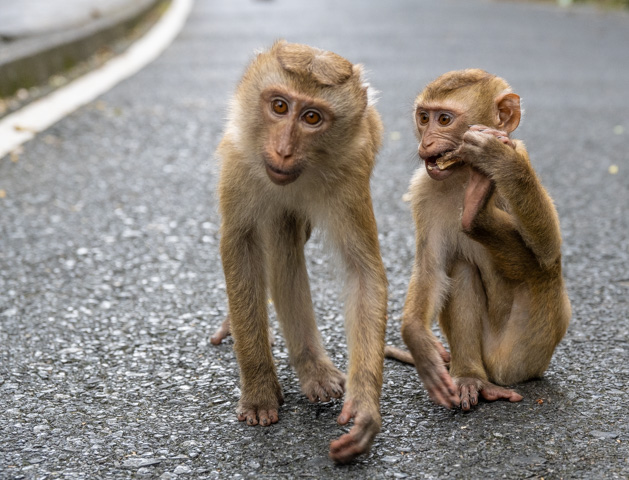
From Phuket Town we visited Wat Chalong which is the biggest and most revered Buddhist temple on the island. The first temple here was built in 1837 but others have been added since.

There is a large 3 story Chedi which is said to contain a bone fragment from Buddha, which is housed at the very top in a glass case.

The whole place feels like a very active site with firecrackers being let off in a big oven to show gratitude for wishes coming true, monks chanting and lots of worshippers mixing with the tourists.

We enjoyed our first few days in Phuket town as we acclimatised to the heat and Asian culture and most importantly recovered from Jet Lag. It seems to me that Phuket is a very soft introduction to Asia with menus at restaurants in English (mostly) and signs in English everywhere.
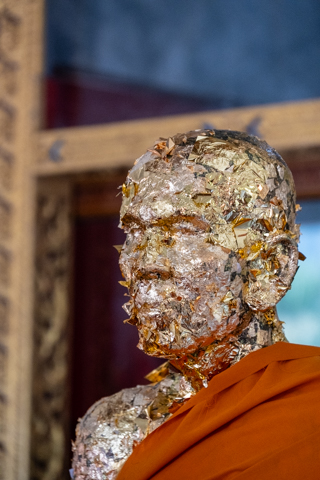
Next stop is Phi Phi Island for a taste of backpacker culture !

Our Last Gasps of France
Time was ticking on and we had a date with a ferry for the end of November. The weather was taking an autumnal turn and our visa was almost at an end.
We needed to make tracks through Brittany, into Normandy and towards Calais.
Our first stop was somewhere that we had missed on the way South, Nantes. This is a Breton city that, as a result of the vagaries of borders, isn’t actually in Brittany.
Nantes is a big city but there is an Aire in the university district which is easily connected to the centre by tram, which an added bonus of being free at the weekend.

We took a tram into the middle of town and headed through the medieval centre to the Chateau de Ducs de Bretagne which is a walled castle in the middle of the city. Unfortunately, rather than showcasing the Chateau and its history the Chateau is the site of the municipal museum of Nantes which tells the history of the city. The most interesting section was on the slave trade and Nantes central role in the French movement of African slaves to the Caribbean.

After learning about the history of Nantes we headed across town to Les Machines D’Ile which is a madcap steampunk workshop showcasing bizarrely constructed moving animals. It’s as though computers and electronics were never invented and all the exhibits are mechanical. The highlight is definitely the massive elephant which is 12 meters tall and takes people on rides around the area while blowing steam from its trunk.

After Nantes we drove northwards to the coast of Brittany to revisit the town of St Malo as we felt that we hadn’t done it justice when we were here previously.

After spending time walking around the streets and around the walls, admiring the impressive townhouses we found a small French bistro to enjoy a fantastic set lunch.

Despite St Malo being virtually destroyed in WW2 it was amazingly rebuilt over a 12 year period ending in 1960 and certainly feels as if it is the original town. The tide here has a large range and it is fascinating to watch the changing face of the town and its beaches between high and low tide, as the receding water makes the fortified islands accessible on foot.
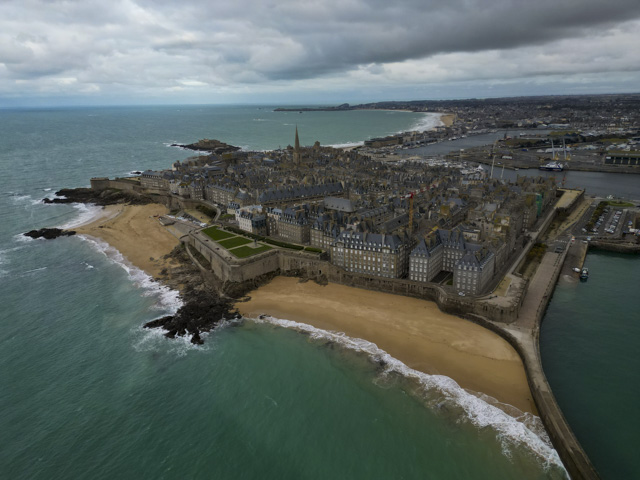
After St Malo we revisited another town that we had enjoyed on our way south, Honfleur. Honfleur is a lovely medieval port town that is full of restaurants and art galleries. It would make a terrific destination for a weekend getaway.
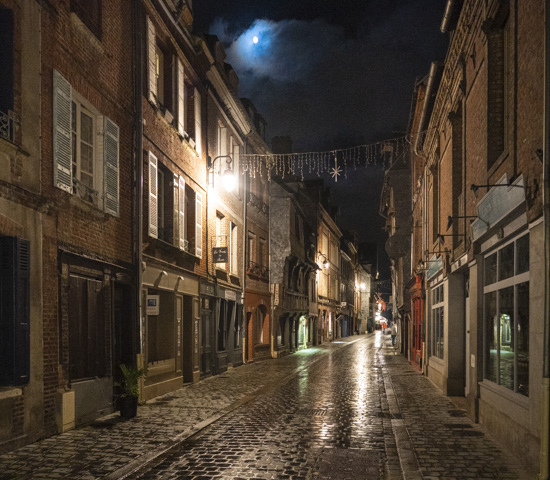
The Aire here is one of the biggest in France with space for over 150 motorhomes with electric hook-ups. Since we were here previously a new electronic access gate has been put in place and the price has been increased from €12 to €14. While it had been close to full in June it was fairly sparsely populated in late November.

We decided that Honfleur would be the site of our ‘Farewell to France’ meal and we splashed out on a fantastic meal at a place called Au Petit Mareyeur. Not only did the food taste fantastic but the presentation was beautiful.

At this point we only had one week to get to Calais so we kept heading in that direction with our next stop being the town of Rouen.

Rouen is the town where Joan of Arc was executed and there is a very good museum dedicated to her rise and fall, the trial that condemned her as well as the re-trial that posthumously acquitted her. We didn’t really know much about Joan of Arc but the story of the peasant girl who persuaded the French King Charles VII that she heard the voice of God and then went on to lead armies to successful victories over the English (during the 100 year war), before being captured and burnt at the stake in 1431 (after what seems to be a fairly biased trial) is a fascinating one and really worth learning about.

The town itself is rammed with medieval buildings and is great to wander around. Near the cathedral the Christmas markets had been set up and were very busy when we went into town.

In Rouen we stayed in the Marina, a 15 minute cycle from the town centre. Almost all of this cycle was along a riverside walkway lined with pubs, clubs and restaurants which I am sure is absolutely buzzing in the summer.

We found an amazing and very posh tea shop in one of the medieval streets where we stopped for a hot chocolate and a slice of cake. Very expensive but absolutely delicious.

We also visited an offbeat museum – the ironmongery museum – which was free to go in and actually much more interesting than its title suggests. It basically features anything and everything that can be made out of iron – from keys and locks, to weapons and fine street furniture.
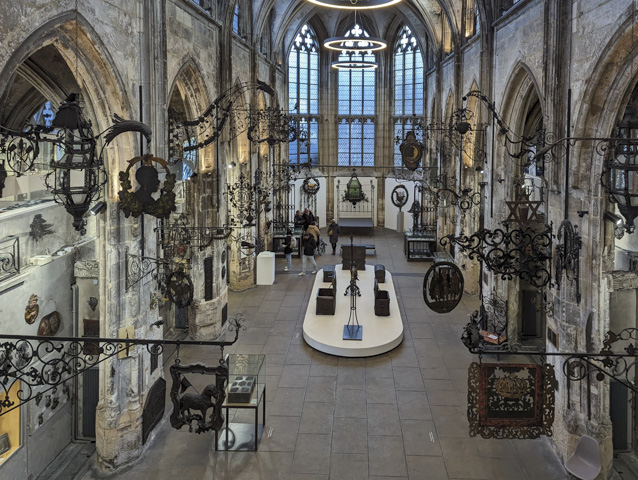
We really enjoyed Rouen and would definitely come back in warmer weather to enjoy the riverside.

On the way into France we had focused on the WWII cemeteries and Normandy beaches having skipped the WWI sites around the Somme. We wanted to put this right on the way back and brush up on our WWI history.
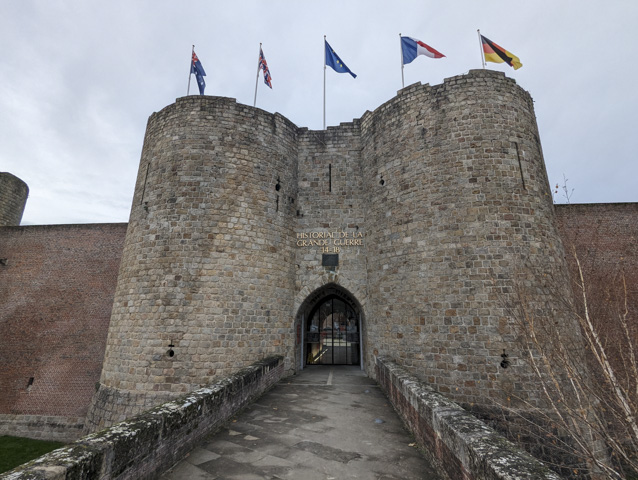
Our first stop was the WWI museum in Peronne, which is situated in a castle in the middle of town.
This taught us some facts and figures but it wasn’t until we visited the battlefields themselves that the reality and the scale of the loss of life really hit us.

The Canadian Parks Service run two fantastic visitor centres on the battlefields of the Somme, staffed by volunteer Canadian Students.

The first one we visited was Beaumont-Hamel, which was the site of intense fighting. On a drizzling and foggy day we walked around the trenches on both the allied forces and German sides of the conflict and contemplated the horrors of the battles and the horrendous loss of life on both sides.
When the allies went over the top at Beaumont-Hamel to begin the ”Big Push” of the Battle of the Somme on 1st July 1916 20,000 were killed and 38,000 were injured. Of the 800 Newfoundlanders who started the day only 68 were to survive.
We moved on from Beaumont-Hamel to the town of Arras where we had hoped to visit the WW1 tunnels that had been built by New Zealand engineers to muster troops before the “Big Push”. Unfortunately we had limited time and couldn’t get on a tour of these tunnels. This remains one to do on another trip to France.

However we did climb the bell tower of the town hall to get a view of the town and the massive Christmas market that was spread across the big squares in the town. We also visited the huge Cathedral of the town.

Our last stop before hitting Calais was the Canadian Memorial at Vimy Ridge. This is the site of another battlefield where the allied and German trenches were only a few metres apart. They were so close that in still conditions it was possible to hear the opposition talking in their trenches.

Some of the trenches here have been restored with concrete sandbags (instead of the original ones) to show what they would really have been like in the war. There are also some underground tunnels that can be accessed on a free tour. These tunnels were used to move between trenches and as the starting point for the sappers who dug deep tunnels under enemy lines, which were then detonated to cause breaches.

Above ground the massive craters from these explosions still pockmark the land.

Also at Vimy Ridge is the massive Canadian memorial for those who died during the war.

In total 425,000 Canadians were mobilised in Europe during WW1 of which 60,661 were killed and 172,000 were wounded. These are huge numbers but overall in WW1 between 9 and 11 million military personnel were killed and between 6 and 13 million civilians. Of the military deaths, around 2/3rds were killed in battle, which marks in out from all previous wars when disease was responsible for the majority of deaths. This really was a new type of conflict the horror of which had never been seen before. I think it is important for us to visit these sites if at all possible, to reflect on this part of history and ensure that the memory of those who lost their lives is kept alive.
After leaving the Somme we completed the short drive to Calais and stayed overnight in some free parking on the harbour wall before catching a ferry first thing in the morning to head back to the UK.

This brought to a close our 6 month tour of France which we have thoroughly enjoyed. A month in the UK seeing family and friends and enjoying a traditional British Christmas beckoned before we head to the Far East to avoid winter in Europe.







